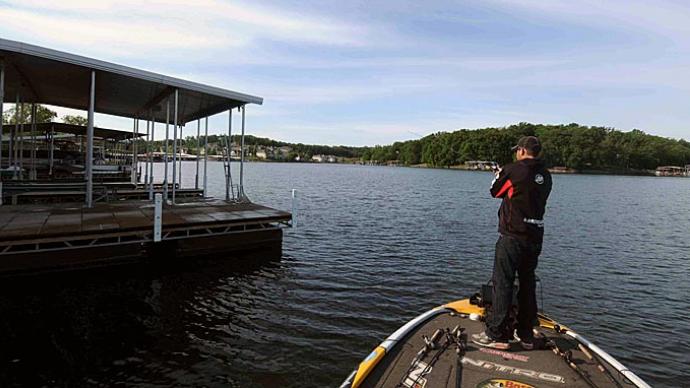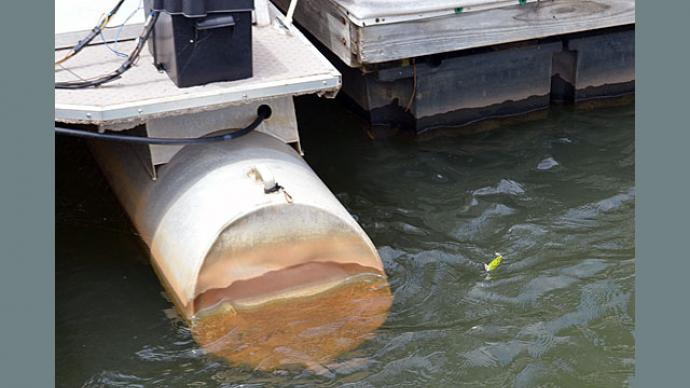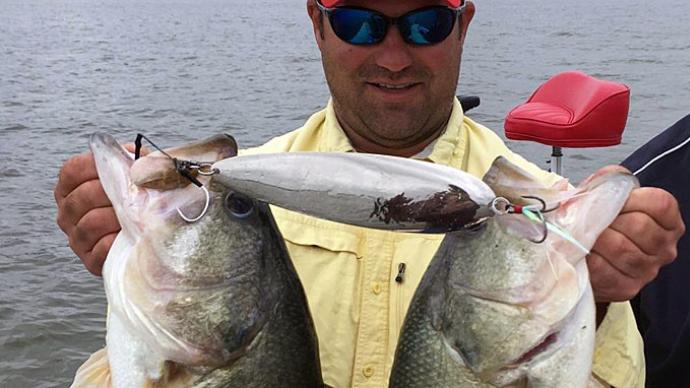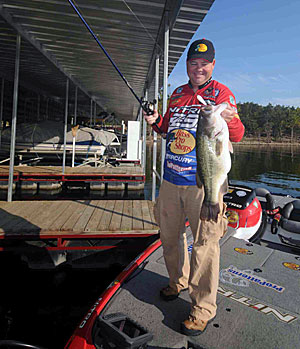
When bass hang around docks on his home waters of Table Rock Lake, Brian Snowden likes to spoon-feed the fish.
The Bassmaster Elite Series pro believes offering a steady diet of spoons to bass holding around docks is effective for several reasons. “It allows you to get a reaction strike and allows you to get a bait to depths of 20 to 40 feet at a rapid speed,” Snowden says. He also notices that the spoons mimic the forage (minnows, shad, and bluegill) that hang around docks.
Spooning around docks starts producing for Snowden about two to three weeks after the spawn when bass move out to deeper water to recuperate. The Missouri pro continues to catch dock bass on spoons throughout the summer and into late fall.
Checking the bottom contour is the key to finding the proper deep-water docks to spoon for bass. “On highland reservoirs, you typically want the end of the dock to be over 40 feet to 80 feet,” Snowden says. “I look for docks sitting close to or next to something underneath the water such as a creek channel, the side of a point, or actually on a point where there might be a deep side that falls off quick and the other side might be flatter.”
Main lake docks are Snowden’s primary targets in the dead of summer, but his ideal spooning spot in the fall is a creek channel that bumps up against four or five docks in a major cove. Docks sitting next to standing timber are also prime spots to spoon for bass.
When bass start staging under docks, the fish are usually shallow (20 feet or less), so Snowden tempts them with the slower fall of a Bass Pro Shops flutter spoon. However, for most of his dock spooning presentations, Snowden relies on a white 3/4-ounce Bass Pro Shops Strata Spoon.
He improves the action of the spoons by replacing the factory-installed split rings with Bass Pro Shops Crane Swivels with Interlock Snaps. He also upgrades the treble hooks on his spoons with Owner ST-36 hooks (number 2 for the Strata Spoon and 2/0 for the flutter version).
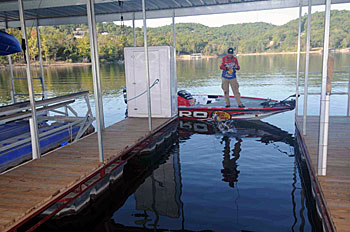
Weather and time of day determine where Snowden pitches his spoons to the floating docks. On the early morning or overcast days, Snowden notices bass tend to roam the edges of docks, so he keys on the front ends and sides of docks and any nearby standing timber. On sunny days, bass tuck into the shade of the docks, so Snowden mainly pitches into the shady areas such as dock wells.
The Table Rock guide pitches his spoons on a 7-4 heavy-action St. Croix Legend Elite rod and Bass Pro Shops Johnny Morris Signature Series baitcast reel (6.4:1 gear ratio) filled with 17- to 20-pound fluorocarbon line. The heavy line comes in handy when Snowden has to throw over boat lifts and the cross members in the dock wells.
“I try to make pitches directly into the dock and let the bait fall and then hop it back until it gets close (to the cross member), then I reel it up,” he says. “You just can’t go too fast because if you get your boat past the stall, your bait is in, and your spoon will often hang in the corners of the cross member.” Then it’s usually time to tie on a new spoon.
Snowden estimates about 85 percent of the bites occur on the spoon’s initial fall. He allows the spoon to fall with a slight bow in his line to increase the action of his lure. “You want the line to come very free off of your reel, so the spoon is falling freely, but you want to pay close attention to any time that thing stops falling because usually, that is a fish,” Snowden says. He recommends setting the hook during the initial fall any time you see the line twitch, stop or move faster than usual because it indicates a fish has sucked in your spoon.
After pitching his spoon, Snowden starts counting down the lure to determine the depth of his first bite. He estimates the Strata Spoon falls at a rate of about 1 1/2 to 2 feet per second, so he counts down to 10 and then engages his reel. Next, he pops the rod “pretty hard” to cause his spoon to rise about 18 to 24 inches and then lets it fall about a foot. As the spoon pendulums back towards the boat, Snowden repeats the rod popping motion again and then reels in the spoon if he fails to trigger a strike.
Snowden finds bass either hugging the bottom or suspending around the docks. Bass are usually on the bottom if Snowden locates fish around docks sitting in the 20-foot depth range. When fishing docks in the 40- to 60-foot range, Snowden pinpoints summertime bass suspended around the thermocline, which is usually about 30 feet deep at Table Rock.
Spooning for dock bass produces both numbers of fish and quality bass for Snowden. If he finds a dock loaded with spotted bass, Snowden usually catches lots of fish in the 14- to 18-inch range. The Missouri pro also knows some docks attract largemouth, and he can usually catch some 4- and 5-pounders from those boat houses.
BassResource may receive a portion of revenues if you make a purchase using a link above.


